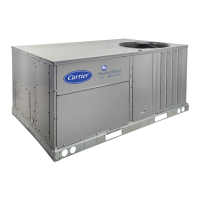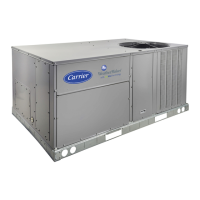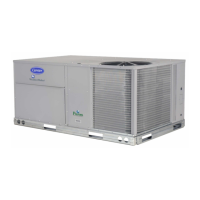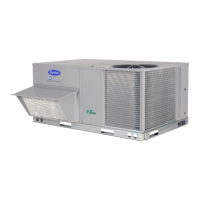ITEM
HEAT
HT.CF
HT.SP
OC.EN
LAT.M
G.FOD
E.FOD
SG.CF
HT.ST
CAP.M
M.R.DB
S.G.DB
RISE
LAT.L
LIM.M
SW.H.T
SW.L.T
HT.P
HT.D
HT. TM
*Some defaults are
Table 65 -- Heating Configuration
EXPANSION
HEATING CONFIGURATION
Heating Control Type
Heating Supply Air Setpt
Occupied Heating Enabled
MBB Sensor Heat Relocate
Fan Off Delay, Gas Heat
Fan Off Delay, Elec Heat
IRANGE IUNITS
0 - 3 sec
80 - 120 dF
Yes/No
Yes/No
45 - 600
10 - 600 sec
I CON POINT
HEATTYPE
SASPHEAT
HTOCCENA
HTLATMON
GAS FOD
ELEC FOD
STAGED GAS CONFIGS
Staged Gas Heat Type
Max Cap Change per Cycle
S.Gas DB min.dF/PID Rate
St.Gas Temp. Dead Band
Heat Rise dF/sec Clamp
LAT Limit Config
Limit Switch Monitoring?
Limit Switch High Temp
Limit Switch Low Temp
Heat Control Prop. Gain
Heat Control Derv. Gain
Heat PID Rate Config
0-4
5 - 45
0-5
0-5
0.05 - 0.2
0 - 20
Yes/No
110 - 180
100 - 170
0 - 1.5
0 - 1.5
60 - 300
AF
AF
dF
dF
sec
HTSTGTYP
HTCAPMAX
HT MR DB
HT SG DB
HTSGRISE
HTLATLIM
HTLIMMON
HT LIMHI
HT LIMLO
HT PGAIN
HT DGAIN
HT,SGPIDR
model number dependent.
IDEFAULT
45
0*
45*
0.5
2
0.06
10
Yes
170*
160*
11
90
Occupied Heating Enable (OC.EN) -- This configuration
only applies when the unit's control type ((bnfiguration
-gUNIT_C TYP) is configured for 1 (VAV-RAT) or 2 (VAV-
SPT). If the user wants to have the capability of performing
heating throughout the entire occupied period, then this config-
uration needs to be set to "YES". Most installations do not re-
quire this capability, and if heating is installed, it is used to heat
the building in the morning. In this case set OCENto "NO".
NOTE: This unit does not support shnultaneous heating and
cooling. If significant simultaneous heating and cooling
demand is expected, it may be necessary to provide additional
heating or cooling equipment and a control system to provide
occupants with proper comfort.
MBB Sensor Heat Relocate (LAT.M) -- This option allows
the user additional performance benefit when under CCN
Linkage for the 2-stage electric and gas heating types. As two-
stage heating types do not "modulate" to a supply air set point,
no leaving air thermistor is required and none is provided. The
evaporator discharge thermistor, which is initially installed up-
strean of the heater, can be repositioned downstrean and the
control can expect to sense this heat. While the control does not
need this to energize stages of heat, the control can wait for a
sufficient temperature rise before announcing a heating mode
to a CCN linkage system (ComfortID_M).
If the sensor is relocated, the user will now have the
capability to view the leaving-air temperature at all times at
Temper atu res --)AIR. T--c( TRL --cLA T.
NOTE: If the user does not relocate this sensor for the 2-stage
electric or gas heating types and is under CCN Linkage, then
the control will send a heating mode (if present) uncondition-
ally to the linkage coordinator in the CCN zoning system
regardless of the leaving-air temperature.
Fan-Off Delay, Gas Heat (GFOD) -- This configuration is
the delay in seconds, after a gas heat mode has ended
(HT.CF=2,3) that the control will continue to energize the
supply fan.
Fan-Off Delay, Elec Heat (E.FOD) -- This configuration is
the delay in seconds, after an electric heat mode has ended
(HT.CF=I) that the control will continue to energize the
supply fan.
HEAT MODE SELECTION PROCESS -- There are two
possible heat modes that the control will call out for heating
control: HVAC Mode = LOW HEAT and HVAC Mode =
HIGH HEAT. These modes will be called out based on control
type (C.TYP).
VAV-RAT (C. TYP = 1) and VAV-SPT (C TYP = 2) -- There
is no difference in the selection of a heating mode for either
VAV-RAT or VAV-SPT, except that for VAV-SPT, space tem-
perature is used in the unoccupied period to turn on the supply
fan for 10 minutes before checking return-air temperature. The
actual selection of a heat mode, LOW or HIGH for both
control types, will be based upon the controlling return-air
temperature.
With sufficient heating demand, there are still conditions
that will prevent the unit from selecting a heat mode. First, the
unit must be configured for a heat type (Configuration--€
HEAT--+HT.(T not equal to "NONE"). Second, the unit has a
configuration which can enable or disable heating in the
occupied period except for a standard morning warmup cycle
((bnfiguration---_HEAT_OC.EN). See descriptions above in
the Setting Up the System section for more information.
If the unit is allowed to select a heat mode, then the next
step is an evaluation of demand versus set point. At this point,
the logic is the sane as for control types SPT Multi-Stage and
SPT-2 Stage, (C TYP = 5,6) except for the actual temperature
compared against set point. See Temperature Driven Heat
Mode Evaluation section.
Tstat-Multi-Stage ((: TYP = 3) and Tstat-2 Stage ((: TYP =
4) -- There is no difference in the selection of a heat mode be-
tween the control types TSTAT 2-stage or TSTAT multi-stage.
These selections only refer to how cooling will be handled.
With thermostat control the Wl and W2 inputs determine
whether the HVAC Mode is LOW or HIGH HEAT.
Wl = ON, W2 = OFF: HVAC MODE = LOW HEAT*
W2 = ON, W2 = ON: HVAC MODE = HIGH HEAT
*If the heating type is either 2-stage electric or 2-stage gas, the
unit may promote a low heat mode to a high heat mode.
NOTE: If W2 = ON and Wl is OFF, a "HIGH HEAT" HVAC
Mode will be called out but an alert (T422) will be generated.
See Alarms and Alerts section on page 93.
SPT Multi-Stage ((:TYP = 5) and SPT 2 Sta_e ((:TYP = 6)
-- There is no difference in the selection of a heat mode
between the control types SPT 2-stage or SPT multi-stage. These
selections only refer to how cooling will be handled. So, for a
valid heating type selected (HT.(T" not equal to zero) the unit is
free to select a heating mode based on space temperature (SPT).
If the unit is allowed to select a heat mode, then the next
step is an evaluation of demand versus set point. At this point,
the logic is the sane as for control types VAV-RAT and
VAV-SPT (CTYP = 1,2), except for the actual temperature
compared against set point. See Temperature Driven Heat
Mode Evaluation section on page 52.
51

